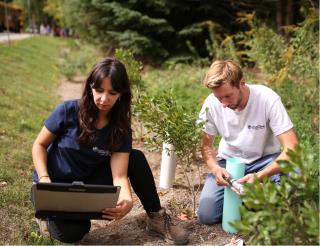Comparison of reactive media for phosphorus removal in a bioretention swale, Living City Campus, Vaughan
 Based on field studies of LID stormwater practices that use soil media to filter out pollutants (e.g. bioretention), it has been determined that phosphorus can leach from the media, resulting in elevated levels in water that has passed through the systems. This phosphorus leaching can limit the adoption of these types of filtration LIDs, particularly on sites that discharge to receiving water systems sensitive to high nutrient levels. Initiated in 2016, this two year study addresses this barrier to LID adoption through a side-by-side performance evaluation of two soil amendments intended to capture and retain phosphorus: (i) Imbrium Systems Sorbtive® Media and (ii) iron-rich sand.
Based on field studies of LID stormwater practices that use soil media to filter out pollutants (e.g. bioretention), it has been determined that phosphorus can leach from the media, resulting in elevated levels in water that has passed through the systems. This phosphorus leaching can limit the adoption of these types of filtration LIDs, particularly on sites that discharge to receiving water systems sensitive to high nutrient levels. Initiated in 2016, this two year study addresses this barrier to LID adoption through a side-by-side performance evaluation of two soil amendments intended to capture and retain phosphorus: (i) Imbrium Systems Sorbtive® Media and (ii) iron-rich sand.
The study site, located at the Green Parking Lot of the Living City Campus, consists of a bioretention area divided into three cells of equal size and contributing drainage areas. The bioretention area receives sheet flow runoff from the adjacent paved parking area, and features a custom drainage system that allows the volume and quality of water draining from each section to be evaluated separately. This side-by-side design allows for the two soil amendments and the unamended control to be compared with respect to their capacity to reduce runoff volumes and contaminant loads, as well as various functional attributes. A reference asphalt pavement in the same parking lot, and subject to similar contaminant sources, serves as the control for the study.
The key objective of this study is to evaluate the effectiveness of engineered media for phosphorous removal from the bioretention runoff, but other parameters examined include runoff volume reduction, surface ponding and infiltration, effluent quality and temperature, pollutant load reductions, and maintenance requirements.
Preliminary findings from this evaluation indicate that the Imbrium Systems Sorbtive® Media does provide a reduction in the total phosphorus and phosphate concentrations in the bioretention outflow, relative to the control. The iron-rich sand reduces phosphate concentrations, but yielded runoff with total phosphorus concentrations comparable to that of the unamended control bioretention cell. Final study results are detailed in the technical brief available under ‘downloads’ on the right side bar.
